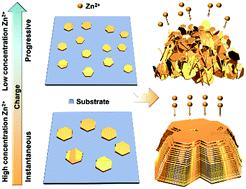当前位置:
X-MOL 学术
›
Energy Environ. Sci.
›
论文详情
Our official English website, www.x-mol.net, welcomes your
feedback! (Note: you will need to create a separate account there.)
A highly reversible zinc deposition for flow batteries regulated by critical concentration induced nucleation
Energy & Environmental Science ( IF 32.4 ) Pub Date : 2021-5-24 , DOI: 10.1039/d1ee00783a Shengnan Wang 1, 2, 3, 4, 5 , Ziyuan Wang 2, 3, 4, 6, 7 , Yanbin Yin 1, 2, 3, 4, 5 , Tianyu Li 1, 2, 3, 4, 5 , Nana Chang 1, 2, 3, 4, 5 , Fengtao Fan 2, 3, 4, 6, 7 , Huamin Zhang 1, 2, 3, 4, 5 , Xianfeng Li 1, 2, 3, 4, 5
Energy & Environmental Science ( IF 32.4 ) Pub Date : 2021-5-24 , DOI: 10.1039/d1ee00783a Shengnan Wang 1, 2, 3, 4, 5 , Ziyuan Wang 2, 3, 4, 6, 7 , Yanbin Yin 1, 2, 3, 4, 5 , Tianyu Li 1, 2, 3, 4, 5 , Nana Chang 1, 2, 3, 4, 5 , Fengtao Fan 2, 3, 4, 6, 7 , Huamin Zhang 1, 2, 3, 4, 5 , Xianfeng Li 1, 2, 3, 4, 5
Affiliation

|
Aqueous zinc-based flow batteries (ZFBs) represent one of the most promising energy storage technologies benefiting from their high safety and competitive energy density. However, the morphological evolution of Zn still remains vague but is significant in the electrolyte, whose Zn2+ concentration constantly decreases during Zn plating. Herein, we present a comprehensive experimental investigation on the morphological evolution and mechanism of deposited Zn in ZFBs and find that the formation of dense blocky Zn is controlled by instantaneous nucleation in concentrated electrolyte (≥0.4 M); in dilute electrolyte (≤0.3 M), Zn becomes mossy because of progressive nucleation. Simultaneously, the dominant plane of Zn crystals changes from (002) to (101). Besides, the recombination of Zn crystals on the same crystal plane was observed by in situ atomic force microscopy (AFM). Significantly, to maintain a high coulombic efficiency (CE >99.5%) and long cycling stability, an operating critical concentration range (≥0.4 M) and the optimized electrolyte utilization rate is proposed according to the Zn morphological evolution. This exploratory work will be beneficial for the further research of Zn anodes in electrochemical energy storage devices.
中文翻译:

通过临界浓度诱导成核调节液流电池的高度可逆锌沉积
水性锌基液流电池 (ZFB) 代表了最有前途的储能技术之一,受益于其高安全性和具有竞争力的能量密度。然而,Zn 的形态演变仍然模糊不清,但在电解质中很重要,其 Zn 2+镀锌过程中浓度不断降低。在此,我们对 ZFB 中沉积 Zn 的形态演变和机制进行了全面的实验研究,发现致密块状 Zn 的形成受浓电解质(≥0.4 M)中的瞬时成核控制;在稀电解质 (≤0.3 M) 中,Zn 由于逐渐成核而变成苔藓状。同时,锌晶体的主晶面从(002)变为(101)。此外,通过原位观察观察到Zn晶体在同一晶面上的复合原子力显微镜(AFM)。值得注意的是,为了保持高库仑效率(CE > 99.5%)和长循环稳定性,根据锌的形态演变提出了操作临界浓度范围(≥0.4 M)和优化的电解液利用率。这一探索性工作将有利于进一步研究锌负极在电化学储能装置中的应用。
更新日期:2021-06-10
中文翻译:

通过临界浓度诱导成核调节液流电池的高度可逆锌沉积
水性锌基液流电池 (ZFB) 代表了最有前途的储能技术之一,受益于其高安全性和具有竞争力的能量密度。然而,Zn 的形态演变仍然模糊不清,但在电解质中很重要,其 Zn 2+镀锌过程中浓度不断降低。在此,我们对 ZFB 中沉积 Zn 的形态演变和机制进行了全面的实验研究,发现致密块状 Zn 的形成受浓电解质(≥0.4 M)中的瞬时成核控制;在稀电解质 (≤0.3 M) 中,Zn 由于逐渐成核而变成苔藓状。同时,锌晶体的主晶面从(002)变为(101)。此外,通过原位观察观察到Zn晶体在同一晶面上的复合原子力显微镜(AFM)。值得注意的是,为了保持高库仑效率(CE > 99.5%)和长循环稳定性,根据锌的形态演变提出了操作临界浓度范围(≥0.4 M)和优化的电解液利用率。这一探索性工作将有利于进一步研究锌负极在电化学储能装置中的应用。











































 京公网安备 11010802027423号
京公网安备 11010802027423号